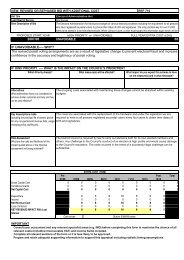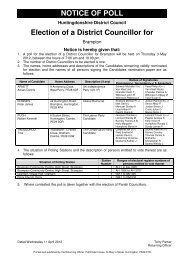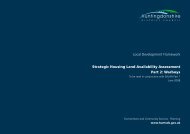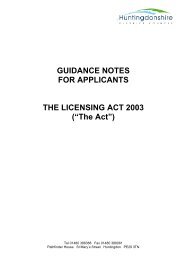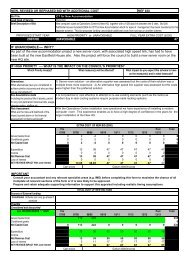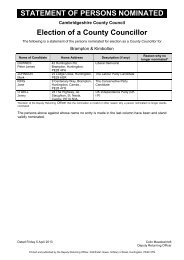Developer Contributions SPD - Huntingdonshire District Council
Developer Contributions SPD - Huntingdonshire District Council
Developer Contributions SPD - Huntingdonshire District Council
- No tags were found...
Create successful ePaper yourself
Turn your PDF publications into a flip-book with our unique Google optimized e-Paper software.
The Planning <strong>Contributions</strong> Framework 3<strong>Huntingdonshire</strong> LDF | <strong>Developer</strong> <strong>Contributions</strong> Supplementary Planning Document3 The Planning <strong>Contributions</strong> Framework3.1 Planning conditions and obligations have, to date, been the standard planning process mechanisms forensuring that development proposals are acceptable and can be granted planning permission. Followingthe legislative and policy changes outlined earlier in this <strong>SPD</strong>, the mechanisms used to ensure appropriatefunding to meet the needs of a planning application have changed to include the Community InfrastructureLevy as well as the aforementioned planning conditions and obligations (S106 Agreements).The Community Infrastructure Levy (CIL)3.2 The Community Infrastructure Levy (CIL) applies to most new developments and charges are based onthe size and type of the new development. The basis for the CIL charge for each development type isdetailed in the <strong>District</strong> <strong>Council</strong>’s Draft Community Infrastructure Levy Charging Schedule, which is beingconsulted on between 23rd November 2011 and 3rd January 2012. It is anticipated that, following anExamination in Public, the <strong>Huntingdonshire</strong> Charging Schedule will be adopted in Spring 2012.3.3 The CIL will generate funding to deliver a range of <strong>District</strong>-wide and local infrastructure projects that supportresidential and economic growth, provide certainty for future development and benefit local communities.Infrastructure needs identified as part of the CIL will not be duplicated in any S106 Agreement.Planning Conditions3.4 Planning conditions are requirements made by the Local Planning Authority for actions that are neededin order to make a development acceptable in planning terms. They cannot be used to secure financialcontributions but can be used to ensure that certain elements related to the development proposal, andwhich may benefit the wider community, are carried out. In <strong>Huntingdonshire</strong> such conditions are likely tocover, amongst other things, the requirement to:undertake archaeological investigationsimplement necessary local site-related transport improvementundertake appropriate flood risk solutions.Planning Obligations3.5 Planning obligations, also known as Section 106 Agreements, are legal agreements between LocalPlanning Authorities and developers, usually negotiated in the context of planning applications. Theirpurpose is to make unacceptable development acceptable in planning terms. Government Circular 05/2005(ODPM) permits planning obligations to be used in the following ways:Prescribe the nature of a development e.g. by requiring a proportion of affordable housing within adevelopmentSecure a contribution from a developer to compensate for loss or damage created by a developmente.g. loss of open space.Mitigate the impact of a development impact, e.g. through increased public transport provision.3.6 The introduction of the Community Infrastructure Levy has restricted the use of planning obligations sothat they must meet three new statutory tests, they cannot be used to double charge developers forinfrastructure, and they cannot be used in the form of a pooled tariff system. Affordable housing and othersite and development specific measures that cannot be funded from the CIL are able to be funded throughplanning obligations.7




